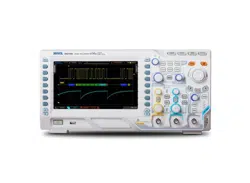Loading ...
Loading ...
Loading ...

Chapter 5 To Trigger the Oscilloscope RIGOL
MSO2000A/DS2000A User’s Guide 5-37
Edge Type:
Press Slope to select the desired clock edge type and it can be set to the rising edge
(
) or falling edge ( ).
Data Type:
Press Pattern to set the effective pattern of the data signal to H (high level) or L
(low level).
Setup Type:
Press SetupType to select the desired setup type.
Setup: the oscilloscope will trigger only according to the setup time. Press
Setup; use or the inner knob of the navigation knob to adjust the setup
time at a relatively smaller step or turn the outer knob of the navigation knob to
adjust the setup time at a relatively larger step. The adjustable range is from 2
ns to 1 s.
Hold: the oscilloscope will trigger only according to the hold time. Press Hold
and adjust the hold time using
or the navigation knob by referring to the
method mentioned above. The adjustable range is from 2 ns to 1 s.
SetupHold: the oscilloscope will trigger according to both the setup time and
hold time. Press Setup and Hold respectively; adjust the setup time and hold
time using
or the navigation knob by referring to the method mentioned
above. Both the adjustable ranges are from 2 ns to 1 s.
Trigger Mode:
Press Sweep to open the trigger mode list and select “Auto”, “Normal” or ”Single”.
For the details, please refer to “
Trigger Mode”. The corresponding status light of
the current trigger mode turns on.
Trigger Setting:
Press Setting to set the trigger parameters (trigger holdoff and noise rejection)
under this trigger type.
Note: Noise rejection is grayed out and disabled automatically when the signal
source is set to any channel of D0-D15.
Trigger Level:
Press DataSrc and use TRI GGER LEVEL to modify the trigger level of the data
source channel. Press ClkSrc and use TRI GGER LEVEL to modify the trigger
level of the clock source channel. For the details, please refer to the introduction of
“
Trigger Level”.
Loading ...
Loading ...
Loading ...
